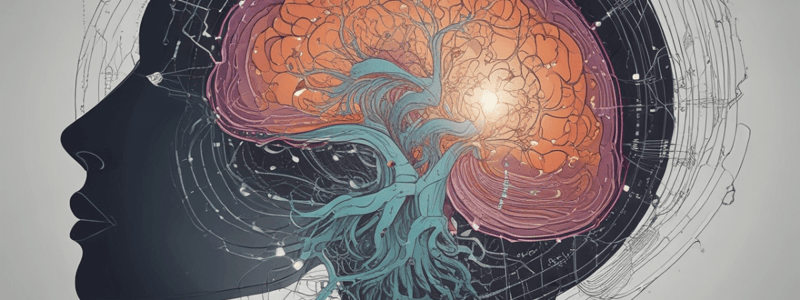Podcast
Questions and Answers
What is the primary difference in brain activity between solving insight problems and non-insight problems?
What is the primary difference in brain activity between solving insight problems and non-insight problems?
- Increased activity in the left frontal-temporal cortex
- Decreased activity in the right cerebral hemisphere
- A burst of high-frequency gamma-band EEG activity over the right anterior temporal lobe (correct)
- Enhanced blood flow in the occipital lobe
What is the effect of direct stimulation of right frontal-temporal cortex on insight problem-solving?
What is the effect of direct stimulation of right frontal-temporal cortex on insight problem-solving?
- It enhances solving of insight problems (correct)
- It disrupts solving of insight problems
- It has no effect on solving insight problems
- It only affects solving of non-insight problems
Which hemisphere is more specialized for logical reasoning and language processing?
Which hemisphere is more specialized for logical reasoning and language processing?
- Left hemisphere (correct)
- Neither hemisphere is specialized for logical reasoning and language processing
- Right hemisphere
- Both hemispheres are equally specialized
What is the effect of priming people to think about the distant future on their problem-solving abilities?
What is the effect of priming people to think about the distant future on their problem-solving abilities?
What is the characteristic of attention in insightful individuals during the resting state?
What is the characteristic of attention in insightful individuals during the resting state?
What is the effect of positive mood on insight problem-solving?
What is the effect of positive mood on insight problem-solving?
What is the effect of extrinsic motivation on creativity?
What is the effect of extrinsic motivation on creativity?
What is the characteristic of EEG activity in the right occipital cortex during the preparation phase prior to the presentation of an insight problem?
What is the characteristic of EEG activity in the right occipital cortex during the preparation phase prior to the presentation of an insight problem?
What is the relationship between broad associations and positive mood?
What is the relationship between broad associations and positive mood?
What is the effect of intrinsic motivation on creativity?
What is the effect of intrinsic motivation on creativity?
What is the main implication of confirmation bias in medical diagnosis and psychotherapy?
What is the main implication of confirmation bias in medical diagnosis and psychotherapy?
What is the main pitfall of a mental set?
What is the main pitfall of a mental set?
What is the Nine Dot problem an example of?
What is the Nine Dot problem an example of?
What is the main characteristic of functional fixedness?
What is the main characteristic of functional fixedness?
What is the Candle problem an example of?
What is the Candle problem an example of?
What is the Horse-and-rider problem an example of?
What is the Horse-and-rider problem an example of?
What is the consequence of being offered a reward for being creative?
What is the consequence of being offered a reward for being creative?
What is the purpose of incubation in problem-solving?
What is the purpose of incubation in problem-solving?
What is the effect of watching a comedy film on problem-solving?
What is the effect of watching a comedy film on problem-solving?
What is the benefit of brainstorming in fostering creativity?
What is the benefit of brainstorming in fostering creativity?
What is the effect of distraction on complex decision-making?
What is the effect of distraction on complex decision-making?
What is the relationship between a messy desk and creativity?
What is the relationship between a messy desk and creativity?
Study Notes
Insight and Non-Insight Problems
- Insight: a sudden and often novel realization of the solution to a problem, contrasting with strategy-based solutions
- Insight problems are solved when the answer appears suddenly, whereas non-insight problems are solved gradually
Neural Basis of Insight
- Critical components of insight are associated with the right cerebral hemisphere (Kounios and Beeman, 2014)
- EEG shows a burst of high-frequency gamma-band activity over the right anterior temporal lobe when solving problems by insight
- fMRI shows a corresponding change in blood flow in this area
- Direct stimulation of right frontal-temporal cortex coupled with inhibition of left frontal-temporal cortex enhances solving of insight problems
Characteristics of Insightful Individuals
- Insightful individuals show greater right hemisphere activity at rest, relative to analytic individuals
- They show more externally oriented attention and reduced occipital alpha-band EEG activity
- They have greater internal focus of attention during the preparation phase prior to the presentation of the insight problem
Factors Affecting Insight
- Priming people to think about the distant future biases them to think abstractly, causing them to perform better on insight and creativity tasks
- Positive mood facilitates insight, probably by increasing attentional scope to include weakly activated solution possibilities
- Broad associations and positive mood are bidirectionally related
Creativity
- Creativity: finding a solution that is novel and useful
- To foster creativity and insight, promote conditions that allow thought and perceptual processes to run more freely
- Intrinsic motivation promotes high levels of creativity, while extrinsic motivation can reduce creativity
Biases and Heuristics
- Confirmation bias: tendency to ask questions that confirm a preconceived notion, leading to inaccurate judgments
- Mental set: tendency to approach a problem in a particular way, especially a way that has been successful in the past but may not be helpful in solving a new problem
- Functional fixedness: tendency to think of things only in terms of their usual functions
Techniques for Fostering Creativity
- Brainstorming: suspending criticism and generating ideas to facilitate creativity
- Incubation: taking a break when stuck on a problem, helping to break out of mental set and see the problem in a new way
Studying That Suits You
Use AI to generate personalized quizzes and flashcards to suit your learning preferences.
Related Documents
Description
Test your understanding of problem-solving strategies, including insight and non-insight problems, and how they differ in terms of solution approaches and neural basis. Explore the role of the right cerebral hemisphere in insight and learn how to distinguish between sudden and gradual problem-solving methods.




